I have been buying eggs and mushrooms from Paul Offer at the Charlottetown Farmer’s Market. I know him to be a man of both good humour and exacting standards, and I feel proud to be one of his customers.
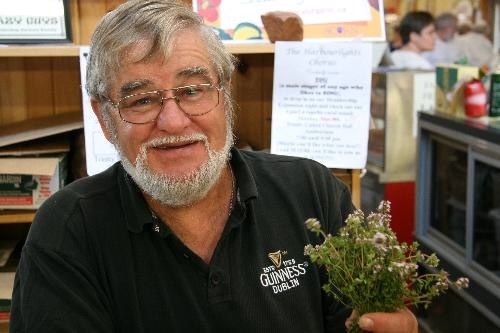
The CBC reported this morning that the dining room that Paul and his wife Jean operate out of the home in Tyne Valley has been ordered closed by the Public Health department because of new Food Premises regulations under the Public Health Act.
This isn’t because they’ve done anything wrong: simply because the new regulations don’t allow public meals to be cooked in private kitchens.
While I sympathize with the desire to enhance food safety, I’m uncomfortable living in a province where people like Paul and Jean Offer, 35 years into a project that’s an anchor in their community, a tourist standout and an important source of income to them, are shut down in its name.
Surely we can find a creative way to allow Paul and Jean to continue doing what they do, can’t we?
The regulations that threaten to shutter the Offers are only in draft form now, and public comment is welcome: send yours to the Chief Public Health Office and to the Minister of Health and Wellness.
And, of course, for now at least, you can make a reservation, for up to 6 people, for supper at The Doctor’s Inn.
It seemed like such a simple job: six sheets of paper, 790 words, 4,695 letters and spaces.
Brenda Whiteway approached me in February to see if I’d be able and willing to typeset and print passages of text for her Confederation Country Cabinet. She’d found me via the man who provides us both with paper – hers for the brush, mine for the press – David Carruthers at Papeterie Saint-Armand in Montreal. Odd that it took David to connect us, as we live only a few miles apart and know many of the same people.
“Six sheets: how hard could that be,” I told myself.
There was funding to buy some new type, and the paper. The passages Brenda had selected were interesting: Jack Layton, Frank Ledwell, Emily Carr, and more.
And Brenda’s larger project, a cabinet of curiousities, tickled me in all the right places.
How could I not.
What I discounted, of course, is that despite my best efforts to cultivate post-apocalyptic neo-luddite letterpress street cred, I am but a babe in the woods when it comes to the printing office: I know the broad strokes, I can print a decent coffee bag.
But lines and lines of poetry and prose, printed evenly, accurately, and by the beginning of May?
Well, that was interesting.
Today, almost 45 days after the first tentative deadline, the final piece – a reprint of a Frank Ledwell poem, reprinted because I’d bungled the citation on an earlier printing – rolled off the press.
To commemorate the end I left the ink on the press and set up a celebratory piece, taking the big bold and familiar Akzidenz Grotesk out and honouring my favourite line of all those I set, from that selfsame Frank Ledwell poem, “Charlottetown Conference”:

Along the way I learned so many things.
I learned, when starting off on a new print job, to leave the chase off the press while the rollers are being inked: that way the type doesn’t get over-saturated with ink, printing is much cleaner, and the cleanup afterwards goes more easily. Unfortunately I learned this – from “General Printing: An Illustrated Guide to Letterpress Printing with Hundreds of Step-by-Step Photos” – halfway through the project, and so suffered through three jobs worth of gloopy over-inked type, something that will be polluting my type cases for years to come.
I learned – after almost 3 years – how to adjust the platen of my Golding Jobber № 8. I should have learned this a long, long time ago, but I’d been afraid that, given that it’s 99 years old, if I removed a bolt here, adjusted a thumb-screw there, the entire thing might come tumbling apart. It didn’t, and the last two jobs in the project went so much quicker because of the simple adjustments I made.
I learned that my old friend Fred Louder – we’ve know each other for almost 20 years, but have probably spent less than 2 hours in the same room – is a fount of printing knowledge, which he dispensed liberally over Facebook chat in recent weeks at times I really, really needed it. Sometimes just explaining the problem at hand to Fred led me to an answer before he replied; more often, though, his counsel proved invaluable.
I learned how to take my “makeready” – the fine-tuning process, once the type is set and on the press, but before printing can start in earnest – to the next level, employing bits of tissue paper (especially cigarette paper, which is cheap, readily available, and comes with its own adhesive; thanks, Fred). There’s years more of learning to go, but at least I know the general terrain now.
I finally, years after meeting him, got to order newly-cast type from Ed at Swamp Press in Northfield, Massachusetts, the 14 point Bodoni that I used for the body of the pieces. Figuring out how to order type had its own learning curve and language; Ed made it easy, and I’m ready for the next time.
I got to have another lovely conversation with David at Saint Armand about his paper, and ordered and quickly received a ream (give or take) of their Canal paper, which proved a joy to print on.
I learned how entering a Zen-like state aids in the sorting of type after a job is complete: if my hands didn’t know the California job case layout before this project, they certainly do now, and the challenge when sorting type back into the case is to switch my brain to an idle state so that it doesn’t interfere with what my hands can do on their own.
I learned that, at 48 years old, I had to carefully budget my time for setting and printing because it really only works when I’m well-rested, well-fed and in a good mood. Staying too late in the evening, as I did a few times, results in frustration, spilled ink and, had I unwisely stayed any longer, accidents. Pushing through without taking breaks results in errors (see aforementioned Frank Ledwell 2.0). Slow and steady. Deliberate. Careful. That’s what works. Keeping the workspace clean – which I haven’t mastered – helps too.
I learned that setting an author’s work allows me to experience it in a way completely unlike simply reading it on the page.
“Its freshness for a hundred leagues to ocean’s briny wave”
“Water was not wet nor deep, just smoothness spread with light.”
“Canada is the scent of pines.”
“Our Hero keeps a precise record of how much he drinks, to the beer.”
“Optimism is better than despair.”
All those lines mean so much more when you’ve plucked each letter from its spot in the case, manipulated it into place in the composing stick, gently transferred it to the chase, locked it into place, whispering each line a hundred times by the times it’s all done, both to double-check and to aid in the process of returning it all to the case.
I learned that Brenda Whiteway is a patient, creative, witty taskmaster, the ideal client for my first big printing job. She took each delay with good humour, and wrote very nice things about me to boot.
And so here’s what I ended up with:
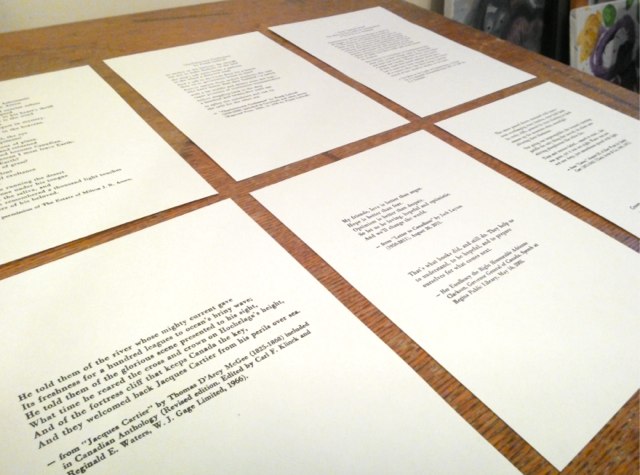
I came nowhere near perfection: the inking on the Jack Layton & Adrienne Clarkson piece is little inconsistent, the Milton Acorn inking is consistent, but with a too much ink, so that it’s bordering on looking like Bodoni bold, the “Frank Ledwell” in the citation for his poem is stands out a little too much, and the “m” in “poems” has a tiny nick in it.
But therein is another lesson to be learned: while my day-to-day life as a digital worker has a comfortable binary precision to it, and the possibility of endless iteration toward perfection, once the job is printed, the type sorted and the piece completed, well, that’s it.
There’s nothing more that I can do.
And so, for the next 50 years I’ll be walking by Brenda’s Confederation Country Cabinet in its home in the Coles Building and seeing that “a” is a little out of place, or wishing I’d staying in the shop an extra half hour that night to make the Emily Carr piece just that little bit cleaner.
Or I can, perhaps, just be satisfied that I worked hard, did the best job I could, learned a tremendous amount in a short space of time, made some new friends and cemented some others, lost some sleep, had some moments of pure printing bliss, and rest easy that in all that is where the craft lies.
Now, off to the Cross Keys for a bracer. Lord knows I need one.
A few weeks ago, reading through the City of Charlottetown’s Pedestrian Mall Bylaw, I noticed that section 5.7 of the bylaw specifically prohibits dogs from the pedestrian mall, with one exception:
No person shall bring, ride, or leave standing any horse or any other animal of any kind whatsoever onto the pedestrian mall excepting a seeing eye dog.
That exception – for “seeing eye dogs” – while laudable, leaves out many other types of service dogs, and so I sent an email to the chair of the Planning Commitee to see if it might be updated.
To my surprise and delight, he agreed that an update was in order, had a change drafted, and this change received 1st and 2nd reading at today’s council meeting; it will, barring any unforeseen actions in the interim, be passed with 3rd reading at the July meeting.
The amendment will simply change “seeing eye dog” to “service animal.”
Who knew it was so easy to get a bylaw changed!
Now, of course, I wasn’t asking for money to be spent, nor for some controversial step to be taken, just a minor wording change, but it reinforces to me that a lot of what’s important about democracy happens not at the barricades, but down in the engine room.
As it happens there were unexpected fruits of earlier labours in evidence at the same council meeting tonight: council approved the holding of a public meeting to review stylistic and wording updates to the Zoning and Development Bylaw, a move prompted, in part, by the presentation I made to the Atlantic Planners Institute last fall, Planning in Secret: Effective Strategies for Keeping the Public Out of the Planning Process, a presentation that suggested, among other things, that simply through adding whitespace and changing case could great things happen:

I presented the same talk to the city’s planning department a few weeks later and, apparently, they took some of my ideas to heart: they’ve reformatted, reorganized and reworded the bylaw and will present the results at a public meeting (date to be announced) for review.
Perhaps a drive toward a more open approach to data and information maintained by the city is a reasonable next project? (Although I’m feeling heady now, and wonder, now that I’m on a roll, if I should ask for citywide espresso-plumbing or mandatory letterpress training for all children).
Catherine and Oliver and Ethan and I were the guests of the Winsloe Lions Club last night at their annual Charter Night dinner – a sort of “closing ceremonies” for the Lions year where pins and awards are given out and steaks and lobsters consumed.
Lions Clubs existed at the very periphery of my awareness until this year: I knew they did good works (pancake breakfasts at Prince Street School to support the Breakfast Program, for example), but otherwise I had them stored away in that part of my mind reserved for fraternal organizations, around the corner from Rotary and across the street from the Kinsmen. And that part of my mind is way, way in the back.
But Lions Foundation of Canada, an umbrella charity supported by Lions Clubs across the country, operates the Dog Guides, the program whence Ethan came into our Oliver’s life and spending a week at the Dog Guides training centre in Oakville and seeing the tremendous generosity of clubs from coast to coast to coast endeared me to the organization in a way that’s hard to describe.
We were in Winsloe mostly because Catherine and Oliver ran into King Lion Jason and his wife Michelle running a photo booth at the Charlottetown Mall where kids could get their picture taken with the Easter Bunny, with the proceeds going to Dog Guides. They saw Ethan, offered to take his photo with Oliver, and talked to Catherine about the upcoming Walk for Dog Guides. And then a few weeks later we got invited to come out to the Charter Night as special guests to allow the club to meet Oliver and Ethan and to allow us to tell them something about how their generosity pays off in our family.
Going to a Lions Club dinner is something that, as anyone who knows me will attest, falls way, way outside my comfort zone. But I feel we have a responsibility to share our story, especially with Lions, and so we happily agreed to attend.
It was an interesting night: we got to meet all of the Winsloe Lions, learn more about what they do, see their dedicated members receive awards for things like “taking the crib night to another level this year,” got a feed of lobster and steak (wherein I learned, again, that I have no idea how to eat a lobster) and a chance at the dessert table (pumpkin pie!).
And then I got to tell the story of Ethan – you can read my speech here.
Everyone we met was generous and supportive and deeply committed to the Dog Guides program. You’d be hard-pressed to find a better bunch of folks on the Island.
Doug Ford is the Lion on Prince Edward Island who represents Lions Foundation (he got his 40-year service pin last night) and I’ve offered to tell the same story to any club who’ll have us on PEI. As Doug is something of a dynamo, I expect we’ll be visiting a lot of clubs over the next while.
Remember, if you want to support Dog Guides directly, there’s nothing stopping you from doing it right now!
Brenda Whiteway wrote a very nice blog post about my little part of her Confederation Country Cabinet project. She also snapped a photo of my beside the Golding Jobber № 8, which is a rare thing indeed, as I’m usually all by myself down in the printing office and the only photos a take are ones of type.
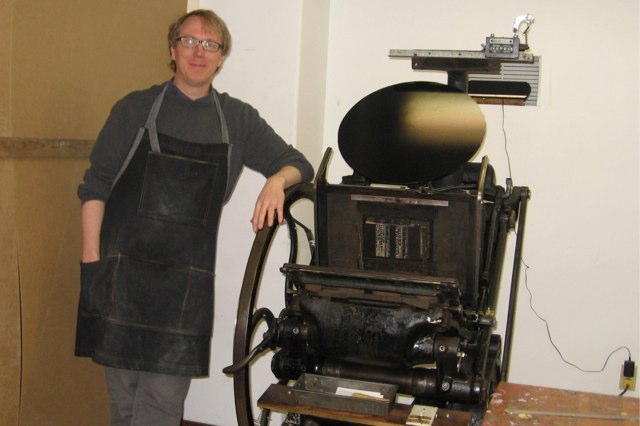
The setting and printing continues: this morning it was Emily Carr and Pauline Johnson, this afternoon it’s J. J. Steinfeld and Monday or Tuesday I’ll reset and reprint Frank Ledwell after an unfortunate setting incident wherein I conflated “Confederation” and “Charlottetown.”
Milton Acorn’s Poem for the Astronauts looks rather like a small city when set in 14 pt. Bodoni. I wasn’t happy with the original run of this Confederation Country Cabinet piece, so I reprinted tonight and I like the result a lot better; sometimes you just need to tear things down and start again.
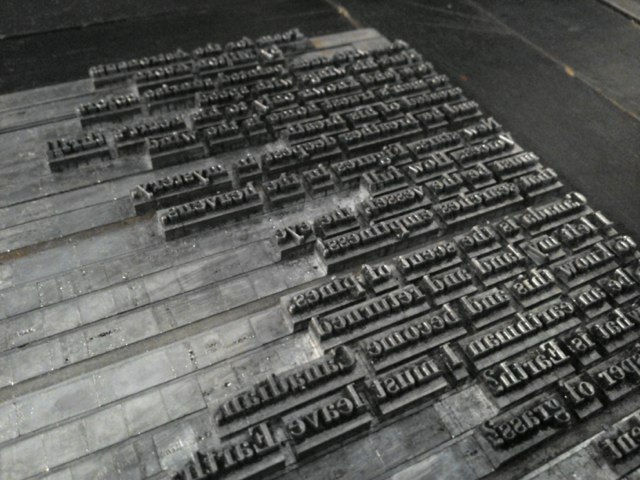
I have Frank Ledwell’s “Confederation Conference” set and ready to print; it’s late, though, and visions of losing a hand to the printing press because I’m groggy convinced me to clean up, go home, and live to print another day.
Despite myself I was always a fan of the Road to Avonlea television series. It was hokey, and not even shot on Prince Edward Island, but it was also endearing and provided a useful lens through which to look at life in contemporary Prince Edward Island.
The archetypal episode would involve some interesting character from away arriving in the village of Avonlea, with hijinks ensuing.
A long-lost huckster cousin of Aunt Heddy would show up and talk Jasper out of his inheritance.
Or a rough-looking carnie would arrive on the train from Charlottetown only to run into Olivia and sweep her off her feet.
(When I think of developer Richard Homburg and his arrival in Charlottetown as a billionaire saviour I tend to think about it in Road to Avonlea terms; it’s far more entertaining).
And so it came to pass that yesterday, while popping down the street for a quick lunch before heading to the dentist, I spied an intriguing character walking down Queen Street: an eclectically dressed woman walking a cat on a leash and carrying a well-worn hula hoop on her shoulder. I was moved to Tweet:

And then I went on with my day.
Later in the day, as I was heading home for supper I ran into my friend Noosh returning from moving his car because of a gas tank explosion on a bus that had just happening in front of his restaurant, Casa Mia Café, up the street. He managed to get his car out of the way before the diesel fuel rolled down under it.
I returned to the office 90 minutes later to find Queen Street closed off between Richmond and Grafton, firefighters on the scene, and absorbent material slurping up the now-flowing-down-the-street diesel fuel. It was an impressive sight, and the Charlottetown Fire Department were all over it.
And then I went on with my day.
Until this morning when I spotted this on the front page of The Guardian newspaper:
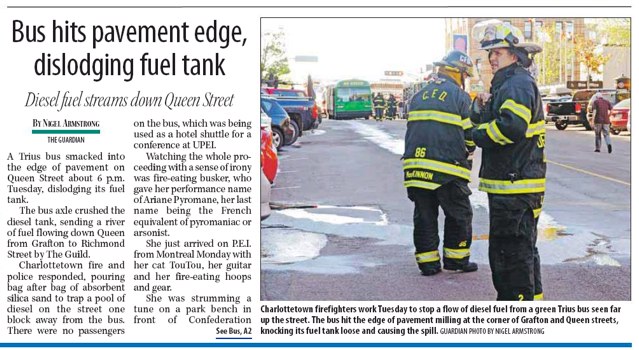
In the reporting of the story of the diesel spill, ace reporter Nigel Armstrong noted that the hula hooped cat-bearing woman I’d seen earlier in the day was, in fact, a fire-eating busker, a fire-eating busker on the scene of the diesel gas tank explosion, no less.
Knowing that Islanders need to know the details, Nigel didn’t disappoint:
Watching the whole proceeding with a sense of irony was a fire-eating busker who gave her performance name of Ariane Pyromane, her last name being the French equivalent of pyromaniac or arsonist.
She just arrived on P.E.I. from Montreal Monday with her cat TouTou, her guitar, and her fire eating hoops and gear.
She was strumming a tune on a park bench in front of Confederation Centre when she heard a sort of explosion just meters away.
“The bus kind of lifted a little bit in the air and then all the gas started spilling everywhere,” said Ariane. “There was no fire, only a little bit of smoke.”
TouTou remained unimpressed and Ariane kept on busking as firefighters and police arrived on scene.
“TouTou remained unimpressed…”
Nigel should get an award for that.
When I’m old and grey I’m sure I’ll pull out yesterday as a good story to tell the young folk: “I remember the day the bus exploded right in front of the fire eater and her amazing magical cat… that was quite a day, yes…”
Such is life in Avonlea, circa 2014.
Over the last 15 years I’ve written 111 posts that mentioned Island Tel and 119 posts that mentioned Aliant, it successor company. Put together, that’s a lot of ink spilled in commentary on the phone company.
I was an Island Tel customer from almost the first day I landed on Prince Edward Island, and over the years we’ve had all sorts of adventures together: the company equipped me with a giant “cellular modem” while the Confederation Bridge was being constructed to allow us to set up the “Island Cam” on the ferry going back and forth across the Northumberland Strait; we worked together on a complicated project in the mid-1990s to equip all of the visitor information centres on the Island with Internet via ISDN; I’ve carried Island Tel mobile phones, used Island Tel dial-up Internet and admired Island Tel commercials. The company even threatened to sue me once.
I stopped being an Island Tel customer a number of years ago, jumping ship to Eastlink, the company’s primary competitor for phone, Internet and television service. Eastlink is no phone company, in the classic “we’ll send out a tech in the middle of the night to ensure you have phone service” model; but I’ve been relatively happen with its service over the years.
But then I met Paul Murray.
Paul works for Bell Aliant here on PEI as the sales manager for the region and several years ago when we were setting up the TeacherNet project at Prince Street School Paul came on board as a sponsor. He did this quickly, efficiently and with good humour, and Bell Aliant continued to support the project for an additional year after the original sponsorship ended.
While there was no expectation of my abandoning Eastlink as part of his arrangement, I felt a gratitude to Paul, and felt it only just that I seek to migrate to Bell Aliant here at the Reinventorium. It took a couple of years – some complicated engineering challenges had to be solved because the conduit into The Guild had been blocked by the construction of a new building – but today I called up Eastlink and cancelled our service after Bell Aliant’s Fiber Op was installed last week.
With the move we jump from 20 Mbps down. 2 Mbps up to 50 Mbps down and 30 Mbps up. Most of the time I don’t notice the difference, but when I do – uploading photos to Flickr, for example – I really notice it.
To my delight, the wireless router that’s our new gateway to bandwidth – it connects to the “media convertor” that turns light into, well, whatever Internet is – is quite capable and supports things like setting up a DMZ, port forwarding, static IP address from DHCP based on MAC address and more. So I’ve also retired the Apple Airport Extreme that’s served us well here for a couple of years.
Given our mercurial history, nobody is more surprised than I to be an Island Tel customer again. And while the days of “when you call, I’ll be there” might be over, it does, in a way, feel good to be back.
There are six panels to be set and printed for the Confederation Country Cabinet. Milton Acorn’s Poem for the Astronauts is the third one I’ve completed. It’s not the longest piece by letter-count, but it’s the “tallest” and was the piece that determined the paper size of 7 inches by 10 inches that all the panels are being printed on.

Work on the Confederation Country Cabinet pieces continues in the press room. After the delay waiting for capital Ks to be freshly cast, there was another pause of a few days waiting for a batch of paper to arrive from Papeterie Saint-Armand in Montreal.
After consulting with Brenda Whiteway (the artist overseeing the project), and visiting the cabinet itself, I ordered some Canal Paper, Saint-Armand’s machine-made paper in both cream and white and it arrived early this week.
There are three pleasant aspects to using this Saint-Armand paper: first, David and his crew at Saint-Armand as simply lovely people, a pleasure to deal with, and a company to be treasured by anyone who appreciates craftsmanship and pride-in-product; second, it was David who connected Brenda and I in the first place (we live only a few miles apart, but it took our paper man to connect artist with printer) and, finally, back in 2010 I got to visit Saint-Armand and see the machine that makes the Canal paper right up close.
With K and paper in hand, I was ready to head back to the print shop. This work is a challenge for reasons beyond simply naivety: I’m using a newly-case 14 pt. Bodini and a decades old 12 pt. Bodini on the same job, which makes the process of “makeready” (the subtle adjustments, with bits of tissue paper and other magic, to make sure everything is evenly inked) more complicated that usual (amplified by my naivety). But, with the wise counsel-by-Facebook from my friend Fred the Printer in Sweden (best piece of advice was to go and buy some cigarette paper, which is perfect for makeready), I’ve made my way, and yesterday I completed two of the six panels.
Here’s a detail from the panel that includes a quote from Jack Layton’s Letter to Canadians and another from Adrienne Clarkson:
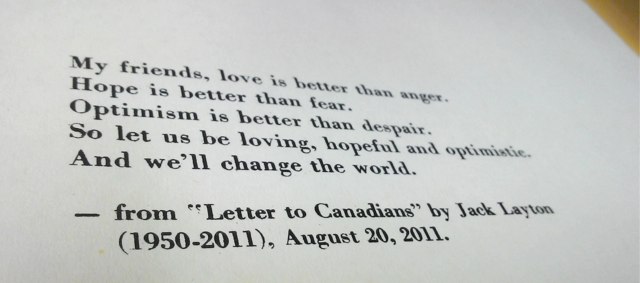
It’s not perfect, but then printing can only approach perfection from a distance and never achieve it; but I’m happy with the result, and the Saint-Armand paper was a joy to print on. Today I’m back to the composing room to set passages from J. J. Steinfeld and Milton Acorn.
 I am
I am